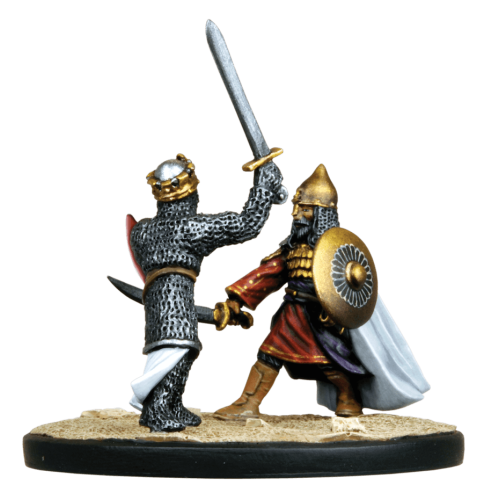Saladin & Richard The Lionheart
Both these giants of the Third Crusade had great respect for the other, but that wouldn’t have stopped them hacking each other to pieces if they had met in combat. And if they had we like to think the scene would have looked something like our ‘Saladin and Richard the Lionheart’ vignette.
O Jerusalem! The city where three religions meet and one deemed worth fighting for ever since its foundation. It is unlikely, however, that two more legendary leaders of their people than Saladin and Richard the Lionheart ever competed for such a prize. But at the close of the 12th century, there they were in the Holy Land deciding the fate of the Holy City.
Richard was born to be a warrior. Already, by the age of 16 he was involved in a rebellion against his father King Henry II, but later asked for forgiveness when defeated – he would not extend the same courtesy to those who rebelled against him a few years later. Undaunted, in the 1180s Richard allied with King Philip II of France to overthrow Henry. Richard beat Henry’s army in 1183 and five years later joined Philip’s expedition that resulted in Henry’s complete defeat and Richard becoming the official heir to the English throne. Henry died two days later and Richard became King. He was crowned in Westminster Abbey five days after his 32nd birthday in September 1189. By then, he had already taken the cross to go on a crusade. When news came that Jerusalem had fallen in 1188, Richard started to organize his kingdom to finance the trip and provide political stability while he was away. When all was in readiness, in 1190, he set sail at the head of 8,000 men.
Saladin came to war comparatively late at the age of 26. Up to then, his training was scholarly and religious, but he soon made up for lost time. His first major action was against a combined Crusader-Egyptian army where Saladin commanded the right wing of his uncle’s army. That led to more fighting in Egypt in a period of intense internecine warfare amongst Muslims. Saladin became vizier of Egypt in 1169 and like Richard was immediately faced with revolts. He put them down with ease and began to expand his horizons. That same year, he smashed a crusader-Byzantine army before besieging Darum the following year. He then destroyed Gaza and took the crusader castle at Eilat. Saladin’s next move was to consolidate his powerbase in Egypt with some minor expansion in the area. In 1174, the Syrians invited Saladin to take power in Damascus, which he did, afterwards consolidating his hold on that region too. In 1175, Saladin defeated his Muslim enemies at the Battle of Hama and wrapped up his internal conquests the next year.
Saladin did not stay at peace long and he was soon at war with the Kingdom of Jerusalem. He defeated Baldwin at Jacob’s Ford in 1179 but the incessant wars with the crusaders and internal challengers continued. His two most important conquests over the next few years were the capture of Aleppo and Mosul, opening the gates to his attempt on Jerusalem. The crusader forces had not been idle, however, attacking Muslim trade routes Saladin’s outlying forces. The decisive moment came in 1187 when Saladin destroyed the combined crusader armies of the Kingdoms of Tripoli and Jerusalem at the Battle of Hattin. Jersusalem fell soon afterwards and only Tyre held out as a Christian city in the Holy Land.
Richard’s passage to the Holy Land was a violent one. His first stop in Sicily led to the sack of Messina. In 1191, Richard seized Cyprus with great bloodshed and later sold it to the Knights Templar, making the island a very useful base of operations for further crusades. Richard finally landed at Acre on 8 June 1191 and helped capture the city. A few months later, Richard’s army and Saladin’s would meet at Arsuf. The Battle of Arsuf was a classic Crusader v Muslim fight. Richard knew that if his heavily armoured Crusaders could maintain their cohesion, the lightly armed but nimble enemy could not exploit any gaps or disarray. Thus, Richard let Saladin’s forces wear themselves down before launching a devastating counter-attack. Saladin’s army fled. The year 1192 saw minor clashes but both Saladin and Richard knew they could not afford a long war. Richard also knew he did not have the force to capture Jerusalem, and Saladin could not defeat the disciplined crusader army. In September, they concluded a peace settlement at the Treaty of Ramla. Richard left to settle affairs at home, and the following year Saladin died of a fever. The meeting of the two was brief but their actions cast long shadows down through history and they are justly remembered as two of the major players who shaped the mediaeval world.














